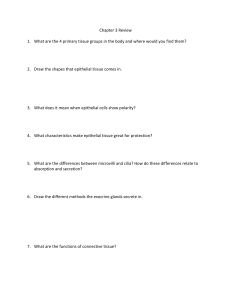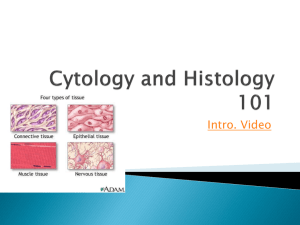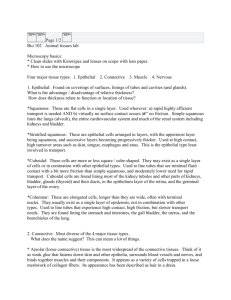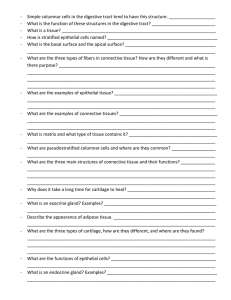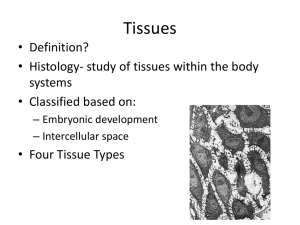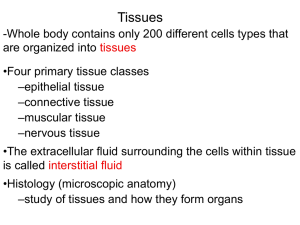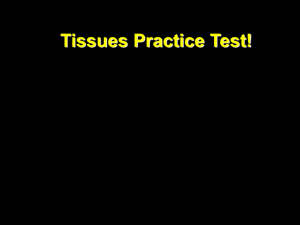Checking for Understanding Questions
advertisement
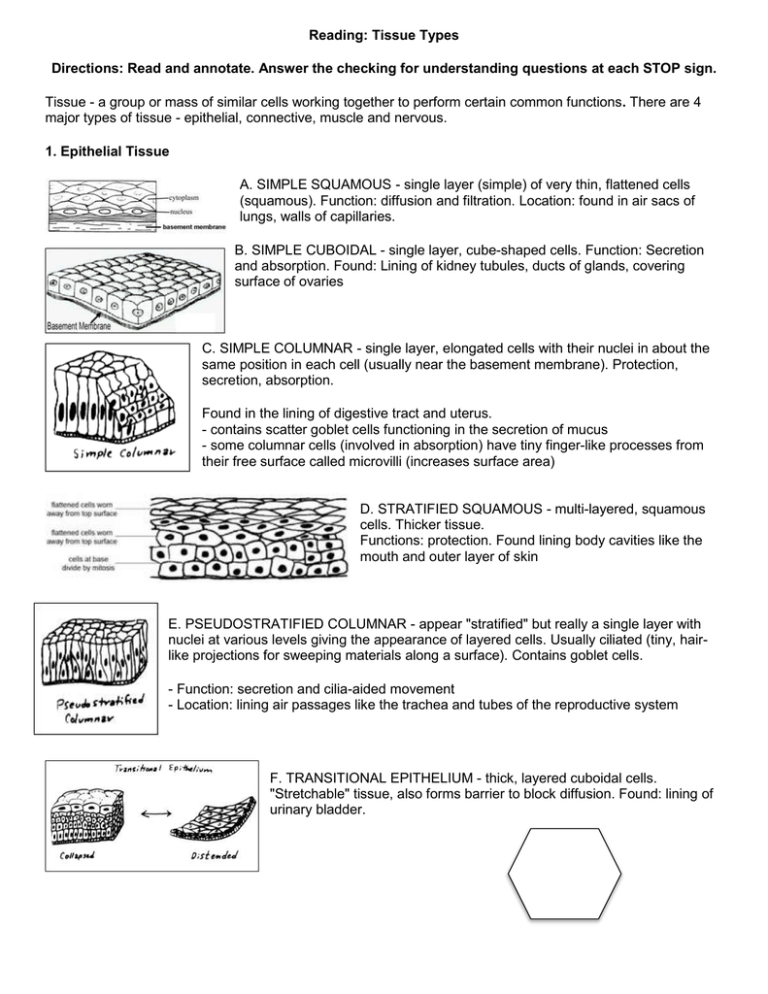
Reading: Tissue Types Directions: Read and annotate. Answer the checking for understanding questions at each STOP sign. Tissue - a group or mass of similar cells working together to perform certain common functions. There are 4 major types of tissue - epithelial, connective, muscle and nervous. 1. Epithelial Tissue A. SIMPLE SQUAMOUS - single layer (simple) of very thin, flattened cells (squamous). Function: diffusion and filtration. Location: found in air sacs of lungs, walls of capillaries. B. SIMPLE CUBOIDAL - single layer, cube-shaped cells. Function: Secretion and absorption. Found: Lining of kidney tubules, ducts of glands, covering surface of ovaries C. SIMPLE COLUMNAR - single layer, elongated cells with their nuclei in about the same position in each cell (usually near the basement membrane). Protection, secretion, absorption. Found in the lining of digestive tract and uterus. - contains scatter goblet cells functioning in the secretion of mucus - some columnar cells (involved in absorption) have tiny finger-like processes from their free surface called microvilli (increases surface area) D. STRATIFIED SQUAMOUS - multi-layered, squamous cells. Thicker tissue. Functions: protection. Found lining body cavities like the mouth and outer layer of skin E. PSEUDOSTRATIFIED COLUMNAR - appear "stratified" but really a single layer with nuclei at various levels giving the appearance of layered cells. Usually ciliated (tiny, hairlike projections for sweeping materials along a surface). Contains goblet cells. - Function: secretion and cilia-aided movement - Location: lining air passages like the trachea and tubes of the reproductive system F. TRANSITIONAL EPITHELIUM - thick, layered cuboidal cells. "Stretchable" tissue, also forms barrier to block diffusion. Found: lining of urinary bladder. Checking for Understanding Questions 1. A tissue is composed of a. specialized cells of one type that perform a common function in the body. b. Organs that transport material in the body c. A cell that produces ATP d. A general mechanism for material to transport in the body 2. These types of cells are ones that are tightly packed and have little space between them. They can be found externally (like on the skin) and internally (like organs) a. Epithelial b. Connective c. Muscle d. Nervous 2. Connective Tissue CATEGORIES OF CONNECTIVE TISSUE A. LOOSE C.T. or AREOLAR TISSUE binds skin to underlying organs and organs to organs, space between muscles, throughout body B. ADIPOSE TISSUE – (FAT) beneath skin, around kidneys and eyeballs, abdominal membranes. Function: Protective cushion, insulation to preserve body heat, stores energy, cells are called adipocytes C. FIBROUS C.T. - dense tissue, closely packed, thick collagenous fibers and fine network of elastic fibers. Few cells, poor blood supply, thus slow healing. Tendons - connect muscles to bones Ligaments - connect bones to bones CARTILAGE (all cartilage cells are called chondrocytes) D. HYALINE CARTILAGE - very fine white (collagenous) fibers. Most common cartilage. Covers ends of bones and joints, noise, respiratory passages. E. ELASTIC CARTILAGE - more flexible and elastic, external ear and larynx. F. FIBROCARTILAGE - very tough, large numerous collagenous fibers. Intervertebral disks, menisci G. BONE TISSUE - Osseus tissue. Rigid due to mineral salts. Layers - lamellae, haversian canals, osteocytes. Checking for Understanding Questions 3. This type of tissue binds structures together, provides support and protection. It also fills empty spaces and produces red blood cells and stored fat which is later used in the body for energy, insulation, and organ protection. a. Epithelial b. Connective c. Muscle d. Nervous 4. This type of tissue is composed of scattered cells that form a matrix: a. Macrophages b. Cuboidal c. Nervous d. Connective H. BLOOD TISSUE - circulates throughout the body 3. Nerve Tissue - Found in brain, spinal cord, nerves A. Neurons - transmit signals B. Neuroglia - protection, support Checking for Understanding Questions 5. This type of tissue is found in the brain and spinal cord. It contains specialized cells that are called neurons and transmit nerve signals. a. Epithelial b. Connective c. Muscle d. Nervous Be sure to use this reading as a SOURCE to provide evidence to support the claim “The human body has different tissue types with different characteristic, functions and locations. Some tissues have similar characteristic, functions and locations”
